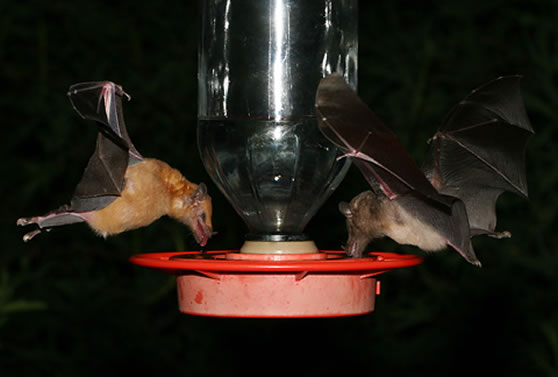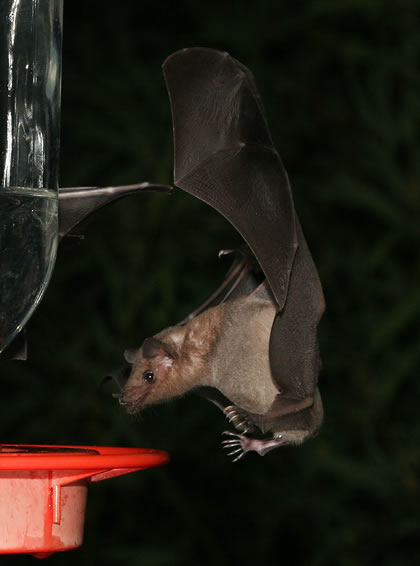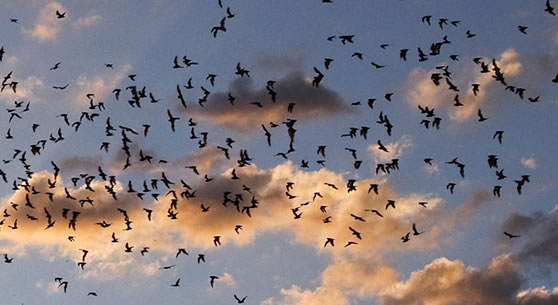Mexican Long-Tongued Bat—Nectar-Feeding Bats?
By Stephen Buchmann, Pollinator Partnership
What’s draining our feeders?

Bird watchers, naturalists, and backyard gardeners in southeastern Arizona were puzzled to find that sugar water feeders they had lovingly set out in the evening for hummingbirds were somehow drained the next morning. Were all the feeders defective somehow?
Hardy individuals staked out the feeders and watched for the sugar usurpers. They were bats! Bats were feeding at hummingbird feeders and draining them dry before first light. Bird watchers and scientists alike were amazed at this new behavior. Nectar-feeding bats that normally fed at cacti and agaves had switched to a bonanza of syrup provided by bird lovers. These species include the lesser long-nosed bat (Leptonycteris curasaoae yerbabuenae) and the Mexican long-tongued bat (Choeronycteris mexicana).
 Lesser Long-nosed Bat (Leptonycteris curasoae yerbabuenae) and a Mexican Long-tongued Bat (Choeronycteris mexicana). Photo Copyright © 2017 T. Beth Kinsey, The Firefly Forest.
Lesser Long-nosed Bat (Leptonycteris curasoae yerbabuenae) and a Mexican Long-tongued Bat (Choeronycteris mexicana). Photo Copyright © 2017 T. Beth Kinsey, The Firefly Forest.
 Lesser long-nosed bat. Photo by Merlin D. Tuttle, Bat Conservation International.
Lesser long-nosed bat. Photo by Merlin D. Tuttle, Bat Conservation International.
This novel bat foraging behavior started about 20 years ago. Retired biologists, residents of the small community of Portal, Arizona, and employees of the nearby Southwestern Research Station of the American Museum of Natural History first noticed the drained hummingbird feeders. The bats and bat watchers continued visiting feeders in nearby cities in southeast Arizona through the intervening years. By 2008, the nectar bats in Tucson had learned the new feeder trick and were raiding hummingbird feeders at night. The Town of Marana, Arizona, continues a bat and hummingbird study to monitor hummingbird feeders to collect data about these bats.
Dr. Kim Winter (now with the USDA Forest Service) wrote an article about the lesser long-nosed bat (Leptonycteris curasaoae yerbabuenae) for a previous Pollinator of the Month article. The rest of this article will focus on the Mexican Long-Tongued Bat (Choeronycteris mexicana).
Mexican Long-Tongued Bat
 Mexican Long-Tongued Bat (Choeronycteris mexicana). Photo by Steve Buchmann.
Mexican Long-Tongued Bat (Choeronycteris mexicana). Photo by Steve Buchmann.
The Mexican Long-tongued Bat (MLTB) ventures inside the borders of the United States in southernmost California, Arizona, New Mexico, and Texas. The MLTB is a member of the diverse tropical leaf-nosed bats, the Phyllostomidae within the order Chiroptera. The leaf-shaped patch at the tip of their snouts likely directs the ultrasonic echolocation cries made by these bats. They literally shout at frequencies we cannot hear through their nostrils! In the past, this bat has also been known as the hog-nosed bat. The MLTB is about 3 inches long and weighs 5/8 ounce (81 to 103 millimeters and 10 to 25 grams). Its fur is grayish or gray brown.
Telling these two bats apart is tricky, but the MLTB has a longer snout and a broad tail membrane with a small but conspicuous tail. It is difficult to tell when both species are at your feeders. However, if photographed the Lesser Long-nosed bat can be differentiated by its reduced tail membrane and no visible tail.
 Mexican Long-tongued Bats have longer, narrower snouts and range in color from brown to grayish brown. Photo Copyright © 2017 T. Beth Kinsey, The Firefly Forest.
Mexican Long-tongued Bats have longer, narrower snouts and range in color from brown to grayish brown. Photo Copyright © 2017 T. Beth Kinsey, The Firefly Forest.
 Lesser Long-nosed Bats have shorter, broader snouts and range in color from a striking yellowish brown to cinnamon gray-brown. Photo Copyright © 2017 T. Beth Kinsey, The Firefly Forest.
Lesser Long-nosed Bats have shorter, broader snouts and range in color from a striking yellowish brown to cinnamon gray-brown. Photo Copyright © 2017 T. Beth Kinsey, The Firefly Forest.
By day, the MLTB roosts in caves, mines, and buildings, often clinging by one foot near the roost entrance. Single young are born to female bats in June and July. These maternal roosts are usually in Mexico. Both species follow a migratory nectar corridor of cactus and agave blooms briefly entering the United States. They are present in the United States during the summer months. By late summer, they migrate south into Mexico and northern Central America by winter.
The main portion of the diet for nectar bats is nectar along with the protein and lipid-rich pollen, which they lick and groom off their fur. During the summer when cactus fruits are ripe, they will also gorge themselves on the fresh fruits of cacti. They may also take some insects to supplement their diets.
Nectar bats are all nectar-feeding specialists and rely mostly upon the seasonal blooms of columnar cacti (e.g., the saguaro, Carnegiea gigantea, and its bigger cousin the cardon, Pachycereus pringlei) and century plants (the genus Agave) for their energetic and nutritional needs. All of the nectar feeding bats have very long, sometimes half their body length, and tubular tongues with brushy tips. They may fly in groups or flocks of a few individuals. They hover ever so briefly in front of blossoms, and in less than a second have thrust head and tongue deep insides blossoms and lapped up the nectar. They are champion long distance flyers and move pollen great distances resulting in outcrossed pollination between unrelated individuals of their host plants.
In the United States, both bat species have been placed on the federal endangered species list though recent censuses in Mexico indicate larger healthier populations. Due to their gregarious roosting, and fear of bats in rural ranch communities, these and other bats are at high risk of cave vandalism and outright wanton killing.
 Bat flock. Photo by Steve Buchmann.
Bat flock. Photo by Steve Buchmann.
Try your hand at observing these gentle beautiful pollinators at a hummingbird feeder in your yard if you live in the right areas for them. You can also photograph them at the feeders. By noticing the presence or absence of a tail, you may figure out which of these two nectar bats you are seeing. Maybe you have both! If you live in southern Arizona, you can become an observer and sign up for the feeder watch program organized by Dr. Ted Fleming and the Arizona Game and Fish Department and Bat Conservation International (See Marana, Arizona, Bat and Hummingbird Study).
Additional Resources
- Carson, M.K. 2010. The Bat Scientists (Scientists in the Field Series). Houghton Miffling Publishers.
- Graham, G. L. 1994. Bats of the World. A Golden Guide from St. Martin’s Press. New York.
- Harvey, M.J., J.S. Altenbach and T. L. Best. 2011. Bats of the United States and Canada. Johns Hopkins University Press, Baltimore, MD.
- Tuttle, M.D. 2005. America’s Neighborhood Bats, Second Revised Edition. University of Texas Press.
- The Pollinator Partnership
- Bat Conservation International
- The Rillito River Project: Bat Night - Although this project is about bridge-roosting Mexican free-tail bats, it is a grass roots organization that attracts thousands of bat watchers each year.
- Marana, Arizona, Bat and Hummingbird Study
- The Firefly Forest: Tucson's Hummingbird Feeder Bats
- Celebrating Wildflowers: Bat Pollination
- Celebrating Wildflowers: Lesser Long-Nosed Bat
- U.S. Fish and Wildlife Service: Endangered Species Program - Find Endangered Species
- Lubee Bat Conservancy

